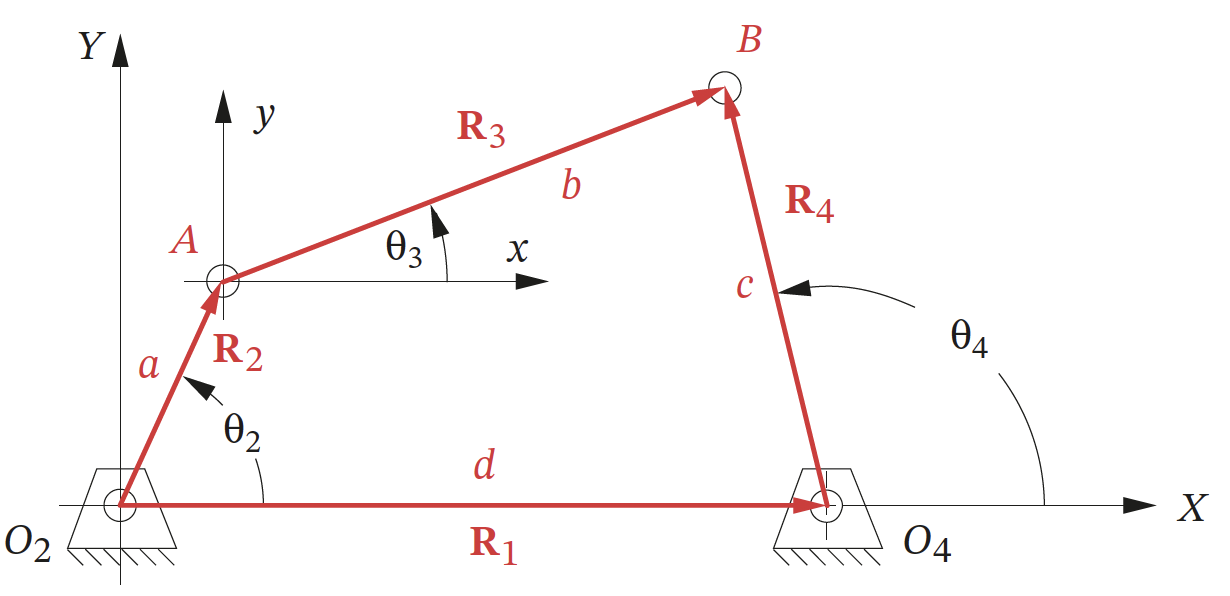Acceleration Analysis (Vector-Algebraic Method)
Fourbar Linkage Vector Loop Equations
The derivation of the vector loop equation for a fourbar linkage mechanism involves defining the position vectors of the links and the angles between them. The fourbar linkage consists of four links connected by four joints, forming a closed loop as shown in the figure below.

Vector Loop Equation
The vector loop equation is derived by summing the position vectors around the closed loop of the fourbar linkage and setting their sum to zero:
\[\mathbf{R}_{A} + \mathbf{R}_{BA} - \mathbf{R}_{BO4} - \mathbf{R}_{O4} = 0 \nonumber\]To obtain an alternative form of the equations, often used in analysis, complex number notation can be used for the position vectors. Using complex notation, the following is obtained
\[a e^{j\theta_2} + b e^{j\theta_3} - c e^{j\theta_4} - d e^{j\theta_1} = 0 \nonumber\]where $a$, $b$, $c$ and $d$ represent the scalar length of each of the links.
Euler’s equation, $e^{j\theta} = (\cos \theta + j \sin \theta)$ may also be substituted into the equations to obtain this form
\[\begin{align*} &a\left(\cos \theta_2 + j \sin \theta_2\right) + b\left(\cos \theta_3 + j \sin \theta_3\right) - \\ & c\left(\cos \theta_4 + j \sin \theta_4\right) - d\left(\cos \theta_1+j \sin \theta_1\right) = 0 \end{align*}\]Solving for Accelerations
Determining accelerations from the vector loop equation is a fairly simple process.

Previously, in Velocity Analysis we differentiated the following equation with respect to time
\[a e^{j\theta_2} + b e^{j\theta_3} - c e^{j\theta_4} - d e^{j\theta_1} = 0 \nonumber\]to give
\[j a e^{j \theta_2} \frac{d \theta_2}{d t}+j b e^{j \theta_3} \frac{d \theta_3}{d t}-j c e^{j \theta_4} \frac{d \theta_4}{d t}=0 \nonumber\]If we differentiate this again with respect to time, simplify and group the terms the following is obtained
\[\left(a \alpha_2 j e^{j \theta_2}-a \omega_2^2 e^{j \theta_2}\right)+\left(b \alpha_3 j e^{j \theta_3}-b \omega_3^2 e^{j \theta_3}\right)-\left(c \alpha_4 j e^{j \theta_4}-c \omega_4^2 e^{j \theta_4}\right)=0 \label{eq2}\]This equation contains terms for the tangential and normal components of the acceleration of points $A$ and $B$ and the acceleration difference of $B$ to $A$. The equation is known as the acceleration difference equation,
\[\mathbf{A_A}+\mathbf{A_{BA}-\mathbf{A_B}} \nonumber\]where
\[\mathbf{A}_A =\left(\mathbf{A}_A^t+\mathbf{A}_A^n\right)=\left(a \alpha_2 j e^{j \theta_2}-a \omega_2^2 e^{j \theta_2}\right) \\ \mathbf{A}_{B A} =\left(\mathbf{A}_{B A}^t+\mathbf{A}_{B A}^n\right)=\left(b \alpha_3 j e^{j \theta_3}-b \omega_3^2 e^{j \theta_3}\right) \\ \mathbf{A}_B =\left(\mathbf{A}_B^t+\mathbf{A}_B^n\right)=\left(c \alpha_4 j e^{j \theta_4}-c \omega_4^2 e^{j \theta_4}\right) \label{eq3}\]Similarly to the process in Velocity Analysis a substitution of $e^{j\theta} = \cos(\theta) + j \sin(\theta)$, can be made in Equation \ref{eq2} to give,
\[\begin{aligned} &{\left[a \alpha_2 j\left(\cos \theta_2+j \sin \theta_2\right)-a \omega_2^2\left(\cos \theta_2+j \sin \theta_2\right)\right]} \\ & \quad+\left[b \alpha_3 j\left(\cos \theta_3+j \sin \theta_3\right)-b \omega_3^2\left(\cos \theta_3+j \sin \theta_3\right)\right] \\ & \quad-\left[c \alpha_4 j\left(\cos \theta_4+j \sin \theta_4\right)-c \omega_4^2\left(\cos \theta_4+j \sin \theta_4\right)\right]=0 \end{aligned} \nonumber\]Multiplying through by $j$,
\[\begin{aligned} & {\left[a \alpha_2\left(-\sin \theta_2+j \cos \theta_2\right)-a \omega_2^2\left(\cos \theta_2+j \sin \theta_2\right)\right]} \\ & +\left[b \alpha_3\left(-\sin \theta_3+j \cos \theta_3\right)-b \omega_3^2\left(\cos \theta_3+j \sin \theta_3\right)\right] \\ & -\left[c \alpha_4\left(-\sin \theta_4+j \cos \theta_4\right)-c \omega_4^2\left(\cos \theta_4+j \sin \theta_4\right)\right]=0 \end{aligned} \nonumber\]and then collecting the terms according to the two components of acceleration, firstly the real part,
\[-a \alpha_2 \sin \theta_2-a \omega_2^2 \cos \theta_2-b \alpha_3 \sin \theta_3-b \omega_3^2 \cos \theta_3+c \alpha_4 \sin \theta_4+c \omega_4^2 \cos \theta_4=0 \label{eq4}\]and then the imaginary part.
\[a \alpha_2 \cos \theta_2-a \omega_2^2 \sin \theta_2+b \alpha_3 \cos \theta_3-b \omega_3^2 \sin \theta_3-c \alpha_4 \cos \theta_4+c \omega_4^2 \sin \theta_4=0 \label{eq5}\]Equations \ref{eq4} and \ref{eq5} can be solved simultaneously to obtain,
\[\begin{aligned} \alpha_3 & =\frac{(a \alpha_2 \sin \theta_2 + a \omega_2^2 \cos \theta_2 + b \omega_3^2 \cos \theta_3 - c \omega_4^2 \cos \theta_4) (c \cos \theta_4)}{(c \sin \theta_4)(b \cos \theta_3)-(b \sin \theta_3)(c \cos \theta_4)} \\ & \quad - \frac{(c \sin \theta_4)(a \alpha_2 \cos \theta_2 - a \omega_2^2 \sin \theta_2 - b \omega_3^2 \sin \theta_3 + c \omega_4^2 \sin \theta_4)}{(c \sin \theta_4)(b \cos \theta_3)-(b \sin \theta_3)(c \cos \theta_4)} \\ \alpha_4 & =\frac{(a \alpha_2 \sin \theta_2 + a \omega_2^2 \cos \theta_2 + b \omega_3^2 \cos \theta_3 - c \omega_4^2 \cos \theta_4)(b \cos \theta_3)}{(c \sin \theta_4)(b \cos \theta_3)-(b \sin \theta_3)(c \cos \theta_4)} \\ & \quad - \frac{(b \sin \theta_3)(a \alpha_2 \cos \theta_2-a \omega_2^2 \sin \theta_2-b \omega_3^2 \sin \theta_3+c \omega_4^2 \sin \theta_4)}{(c \sin \theta_4)(b \cos \theta_3)-(b \sin \theta_3)(c \cos \theta_4)} \end{aligned}\]and having calculated $\alpha_3$ and $\alpha_4$, the linear accelerations, $\mathbf{A_A}$, $\mathbf{A_{BA}}$ and $\mathbf{A_B}$ can be determined by substituting Euler’s identity into Equations \ref{eq3}.
\[\begin{aligned} \mathbf{A}_A & =a \alpha_2\left(-\sin \theta_2+j \cos \theta_2\right)-a \omega_2^2\left(\cos \theta_2+j \sin \theta_2\right) \\ \mathbf{A}_{B A} & =b \alpha_3\left(-\sin \theta_3+j \cos \theta_3\right)-b \omega_3^2\left(\cos \theta_3+j \sin \theta_3\right) \\ \mathbf{A}_B & =c \alpha_4\left(-\sin \theta_4+j \cos \theta_4\right)-c \omega_4^2\left(\cos \theta_4+j \sin \theta_4\right) \end{aligned}\]